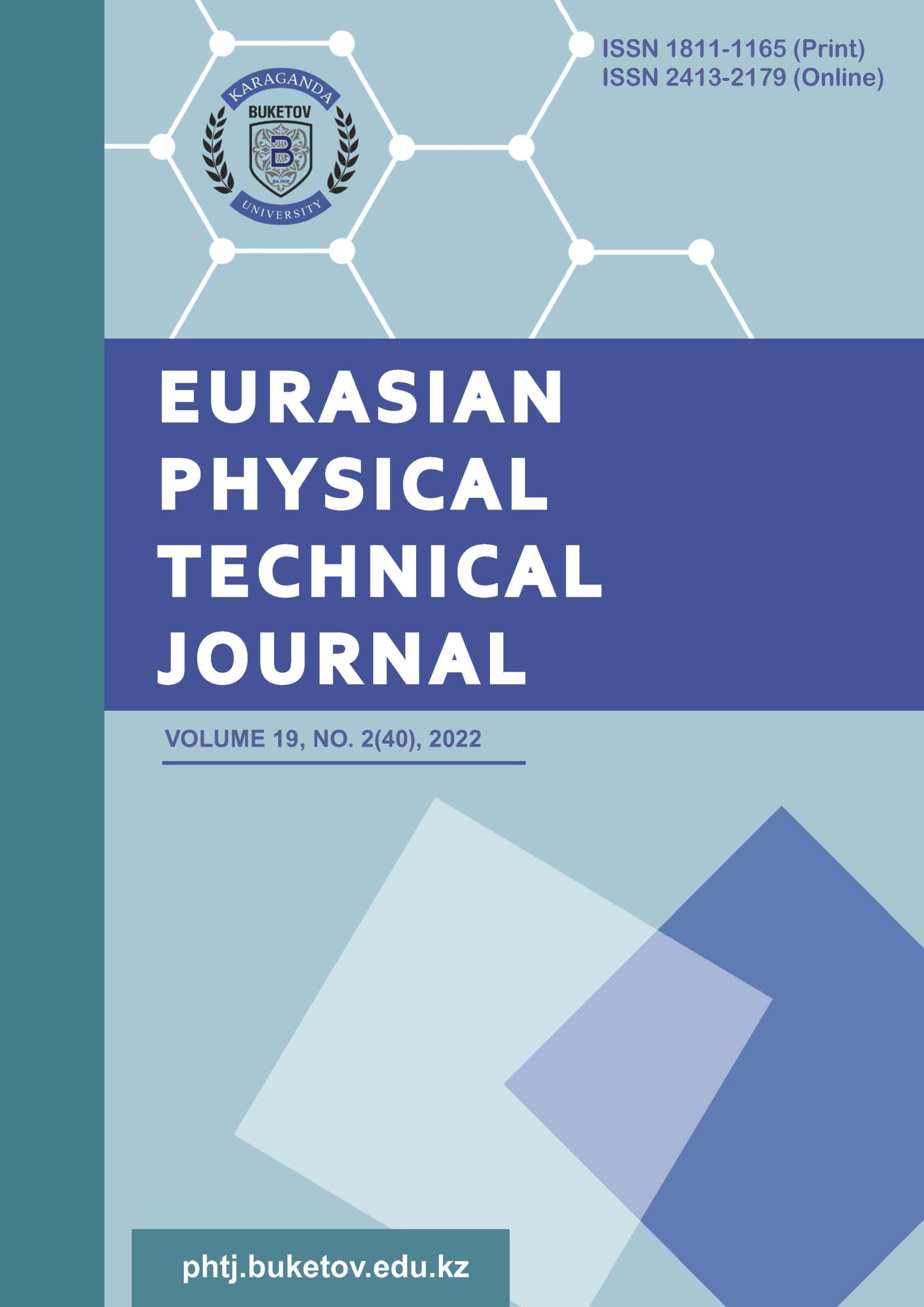THE EFFECT OF LASER ENERGY DENSITY ON THE PROPERTIES OF GRAPHENE DOTS
DOI:
https://doi.org/10.31489/2022No2/30-34Keywords:
graphene oxide, graphene dots, laser ablation, structure, optical propertiesAbstract
The structural and optical properties of dots based on graphene oxide (GO) obtained by laser ablation
method with various energy densities of radiation were studied. It was shown that after laser ablation, the average
lateral size of GO sheets was decreased from 1280–1900 nm to 230±95 nm and 110±42 nm for samples prepared
at a laser radiation with energy density of E~15 and 21 mJ/cm2
, respectively. Raman spectroscopy data showed
that after ablation, the ID/IG ratio decreased from 1.04 to 0.97, indicating an increase in the number of sp2
-
hybridized domains in GO after ablation. A change in the energy density has practically no effect on a change in
its functionalization, as well as the ordering of sp2
domains inside a GO sheet. The optical density of GO
dispersions and the intensity of their fluorescence depend on the ablation conditions. For non-ablated dispersions
along with the luminescence band at 450 nm, additional band appears in the spectrum with a maximum at about
600 nm. After ablation the distribution of particles becomes more uniform, as evidenced by both the change in the
shape of the GO luminescence band and the constancy of the fluorescence lifetime upon registration at different
wavelength.
References
Kim H.J., Bang I.C., Onoe J. Characteristic stability of bare Au-water nanofluids fabricated by pulsed laser ablation in liquids, Opt. Lasers Eng. 2009, Vol. 47, pp. 532–8.
Ganeev R.A, Baba M., Ryasnyansky A.I., Suzuki M., Kuroda H. Characterization of optical and nonlinear optical properties ofsilver nanoparticles prepared by laser ablation in various liquids. Opt. Commun. 2004, Vol. 240, pp. 437–48.
Moniri S., Ghoranneviss M., Hantehzadeh M.R., Asadabad M.A. Synthesis and optical characterization of copper nanoparticlesprepared by laser ablation, Bull. Mat. Sci. 2017, Vol. 40, pp. 37–43.
Atiaf K.J., Abbas Q.A. Synthesis of graphene oxide nanoparticles by laser ablation system. Iraqi J. Sci. 2020, Vol. 61(9), pp. 2241–2250.
Dell’Aglio M., Gaudiuso R., De Pascale O., De Giacomo A. Mechanisms and processes of pulsed laser ablation in liquids duringnanoparticle production. Appl. Surf. Sci. 2015, Vol. 348, pp. 4–9.
Amendola V., Meneghetti M. Laser ablation synthesis in solution and size manipulation of noble metal nanoparticles. Phys.Chem. Chem. Phys. 2009, Vol. 11, pp. 3805–3821.
Kim S., Hwang S.W., Kim M., Shin D.Y., Shin D.H. Anomalous behaviors of visible luminescence from graphene quantum dots: interplay between size and shape. ACS Nano, 2012, Vol. 6, pp. 8203–8208.
Lin T.N., Chih K.H., Yuan C.T., Shen J.L., Lince C.A.J., Liud W.R. Laser-ablation production of graphene oxide nanostructures: from ribbons to quantum dots. Nanoscale, 2015. Vol. 7, pp. 2708–2715.
Seliverstova E., Ibrayev N., Menshova E. Modification of structure and optical properties of graphene oxide dots, prepared by laser ablation method. Fullerenes, Nanotubes, Carbon Nanostruct., 2022, Vol. 30( 1), pp.119-125.
Seliverstova E., Ibrayev N., Menshova E., Alikhaidarova E. Laser modification of structure and optical properties of N-doped graphene oxide. Mater. Res. Express, 2021, Vol. 8(11), pp. 115601(1-5).
Zhu S., Song Y., Zhao X., Shao J., Zhang J., Yang B. The photoluminescence mechanism in carbon dots (graphene quantum dots, carbon nanodots, and polymer dots): current state and future perspective. Nano Res., 2015, No. 2, pp. 355–381.
Ganash E.A., Al-Jabarti G.A., Altuwirqi R.M. The synthesis of carbon-based nanomaterials by pulsed laser ablation in water. Mater. Res. Express, 2019, No. 1, pp. P. 015002 (1–10).
Hoffman J., Chrzanowska J., Kucharski S., Moscicki T., Mihailescu I.N., Ristoscu C., Szymanski Z. The effect of laser wavelength on the ablation rate of carbon. Appl. Phys. A, 2014, Vol. 117, pp. 395–400.
Hoffman J. The effect of recoil pressure in the ablation of polycrystalline graphite by a nanosecond laser pulse. J. Phys. D: Appl. Phys., 2015, Vol. 48, pp. 235201 (1–8).
Ibrayev N.Kh., Dzhanabekova R.Kh., Amanzholova G.S. Spectral and luminescent properties of carbon quantum dots functionalized with N- and S-contaning groups. Euras. Phys. Tech. J., 2021, Vol. 18, No.2(36), pp. 12-17.
Wang D.H., Choi D.W., Li J., Yang Z.G., Nie Z.M., Kou R. Self-assembled TiO2-graphene hybrid nanostructures for enhanced Li-Ion insertion, ACS Nano, 2009, Vol. 3, pp. 907–914.
Wang X., Zhi L., Muellen K. Transparent, conductive graphene electrodes for dye-sensitized solar cells, Nano Lett., 2008, Vol. 8, pp. 323–327.
Ng Y.H., Lightcap I.V., Goodwin K., Matsumura M., Kamat P.V. To what extent do graphene scaffolds improve the photovoltaic and photocatalytic response of TiO2 nanostructured films. J. Phys. Chem. Lett., 2010, Vol. 15, pp. 2222–2227.
Li Q., Guo B.D., Yu J.G., Ran J.R., Zhang B.H., Yan H.J., Gong J.R. Highly efficient visible-light-driven photocatalytic hydrogen production of CdS-cluster-decorated graphene nanosheets. J. Am. Chem. Soc., 2011, Vol. 133, pp. 10878–10884.
Ozer L.Y., Garlisi C., Oladipo H., Pagliaro M., Sharief S.A., Yusuf A., Almheiri S., Palmisano G. Inorganic semiconductors-graphene composites in photo(electro)catalysis: synthetic strategies, interaction mechanisms and applications. J. Photochem. Photobiol. C, 2007, Vol. 33, pp. 132–164.
Zhang Z., Wang C., Zakaria R., Ying Y. Role of particle size in nanocrystalline TiO2–based photocatalysts. J. Phys. Chem.: B, 1998, Vol. 102, pp. 10871–10878.
Dubey P.K., Tripathi P., Tiwari R.S., Sinha A.S.K., Srivastava O.N. Synthesis of reduced graphene oxide-TiO2 nanoparticle composite systems and its application in hydrogen production. Int. J. Hydrogen Energ., 2014, Vol. 39, pp. 16282–16292.
Thakur K., Kandasubramanian B. Graphene and graphene oxide-based composites for removal of organic pollutants: a review. J. Chem. Engineer. Data, 2019, Vol. 64(3), pp. 833-867.
Zhumabekov A.Zh., Ibrayev N.Kh., Seliverstova E.V. Investigation of photocatalytic activity of TiO2–GO nanocomposite. Euras. Phys. Tech. J., 2019, Vol. 16, No. 1, pp. 42–46.
Jorio A., Dresselhans M., Saito R., Dresselhaus G.F. Raman spectroscopy in graphene related systems. Verlag: Wiley-VCH, 2011, 356 p.
Parker С. Photoluminescence of solutions. Mir, 1972, 510 p. [In Russian]













